In mid 1944, the Germans introduced jet and rocket propelled aircraft against the Allied bomber forces flying over the Germany. The allies first operational jet fighter, the British Gloster Meteor saw limited action but never encountered the German jets in aerial combat. The Allies propeller driven fighters escorting the bombers began encountering these fast bogies and soon developed tactics to combat the new threat. Like all the German wonder weapons of WWII, their jet and rocket aircraft were “Too little, too late”.
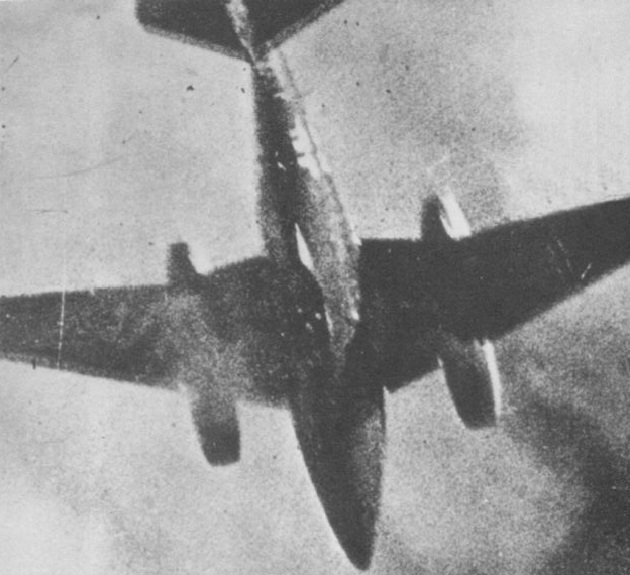
Film: US 8th Air Force engages German ME 163 Rocket Planes and ME 262 Jet Fighters
Me 262
The first production jet fighter, the Me 262A-1a, entered service in July 1944. This variant, nicknamed the Schwalbe (“Swallow”) for the fighter versions, or Sturmvogel (“Storm Bird”) for the fighter-bomber versions, was powered by two 8.8 kN (1,980 lbf) Junkers Jumo 004 axial-flow 004B-1 jet engines and was armed with four 30mm (1.18-inch) MK 108 cannons in the nose. The MK 108 cannon had a relatively low muzzle velocity of 540 meters per second (1,772 feet/sec) and were accurate only at short range. Four or five hits were typically needed to shoot down a B-17 bomber. The Me 262’s Jumo 004 engines required careful nursing by the pilot and they were particularly vulnerable during take off and landing.
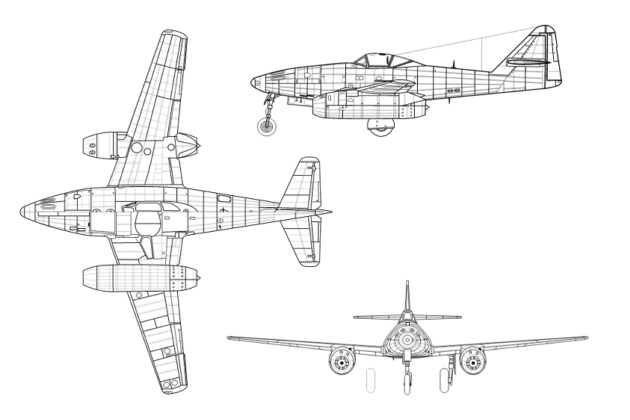
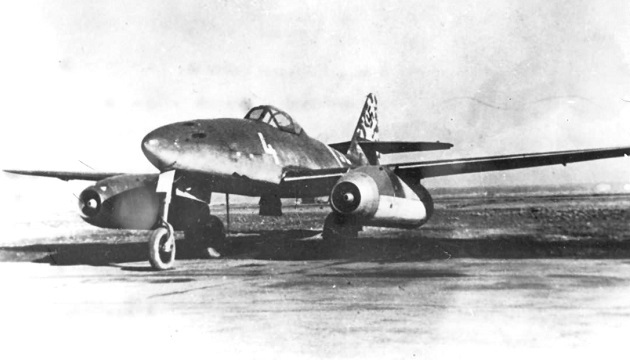
Film: Me 262 – Messerschmitt jet fighter – Luftwaffe Schwalbe
Film: ME262 Jet Propelled – 250003-14
Me 163
The Messerschmitt Me 163 Komet (“Comet”) was the only operational rocket-powered fighter aircraft in history and the first piloted aircraft of any type to exceed 1000 km/h (620 mph) in level flight. Around 300 Me 163 production aircraft were built and were armed with two 30mm MK 108 cannons in the wing roots.
Technically, the Komet was a rocket-powered glider. For takeoff, a pair of wheels, each mounted onto the ends of a specially designed cross-axle formed a takeoff dolly which was mounted underneath the Komet. At a speed of over 320 km/h (200 mph), the Komet would take off from the ground on its two-wheeled dolly. The Komet would be kept at level flight at low altitude until the best climbing speed of around 676 km/h (420 mph) was reached, at which point it would jettison the takeoff dolly. Ground personnel would retrieve the takeoff dolly for the next take off. The Komet would then pull up into a steep 70° angle of climb, zooming up to the enemy bombers altitude like a “bat out of hell.” Once at the bombers altitude, it would level off and quickly accelerate to around 880 km/h (550 mph) or faster, which no Allied fighter could match. The Komet only had a short duration of the powered flight to attack the enemy bombers. Once the Komet’s rocket engine has exhausted its propellant, the powerless Komet would glide back down for a landing at its home airfield.
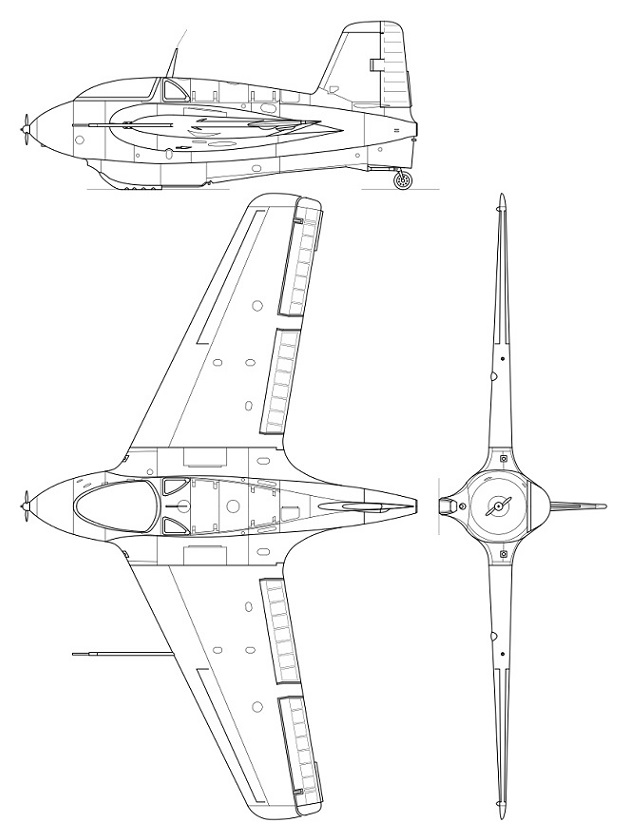
In combat, the Komet turned out to be difficult to attack enemy aircraft. Its tremendous speed and climb rate meant its target was reached and passed in a matter of seconds. Although the Komet was a stable gun platform, it required excellent marksmanship to shot down an enemy bomber. A new tactic was soon developed where the Komet would zoom up through the Allied bomber formation to an altitude of 40,000 feet (12,000 meters) in about three minutes, and then go into power dive down through the bomber formation again. This gave the pilot two brief chances to aim and fire a few bursts of 30mm cannon fire at the enemy bomber’s long wingspan before the Komet exhausted its rocket propellant.
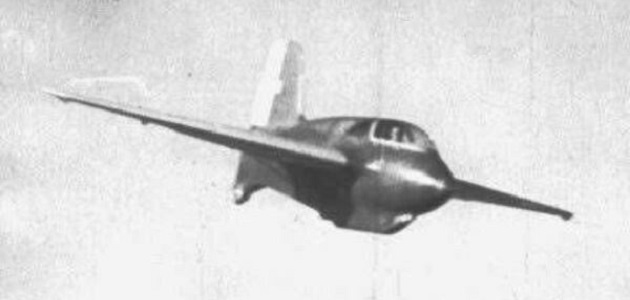
The initial combat trial missions of the Me 163B were conducted with Erprobungskommando 16 (EK 16) “Testing-command”. During the winter and spring of 1944, Major Späte formed the Luftwaffe’s first dedicated Me 163 fighter wing, Jagdgeschwader 400 (JG 400), at Brandis, near Leipzig. JG 400’s purpose was to provide additional protection for the Leuna synthetic gasoline works which the Allies raided frequently during almost all of 1944. Another group was stationed at Stargard near Stettin to protect the large synthetic fuel plant at Pölitz (today Police, Poland). More defensive units of rocket fighters were planned for Berlin, the Ruhr, and the German Bight.
Film: Me 163 Komet (comet) Luftwaffe rocket fighter
Film: Me 163A Testing
Film: Me 163B Testing
Ar 234
The Arado Ar 234 Blitz (“lightning”) was the world’s first operational jet-powered bomber, built by the German Arado company. It was produced in limited numbers (only 214 were built) and was almost entirely used for aerial reconnaissance equipped with two Rb 50/30 or Rb 75/30 cameras. On 2 August 1944, the Ar 234A was the first jet aircraft used for a reconnaissance mission, flown by Erich Sommer. Cruising at about 740 km/h (460 mph) at over 9,100 meters (29,900 feet), the seventh prototype flew the first undetected reconnaissance mission over the UK by a Luftwaffe jet.
The Ar 234B was the fast bomber variant. The fuselage design was very slender and filled with fuel tanks, leaving no room for an internal bomb bay, so the bomb load was carried on external racks and it had no defensive armament. The normal bomb load consisted of two 500 kg (1100 lb) bombs suspended from the engines or one large 1000 kg (2200 lb) bomb semi-recessed in the underside of the fuselage, with maximum bomb load being 1500 kg (3310 lb).
The long takeoff runs caused several accidents which led to the use of twin jettison-able liquid fuel Starthilfe rocket assisted takeoff units, one mounted under each outer wing. The Jumo 004 jet engines had constant flame outs and required overhaul or replacement after about 10 hours of operation.
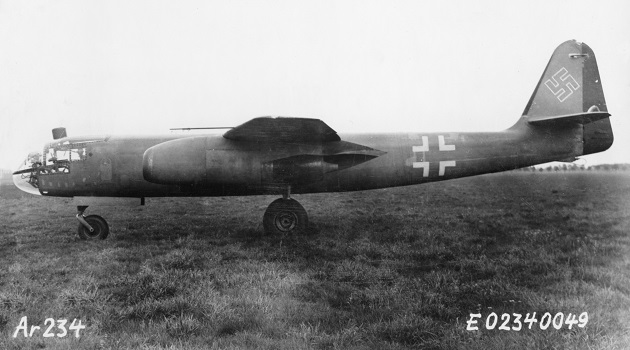
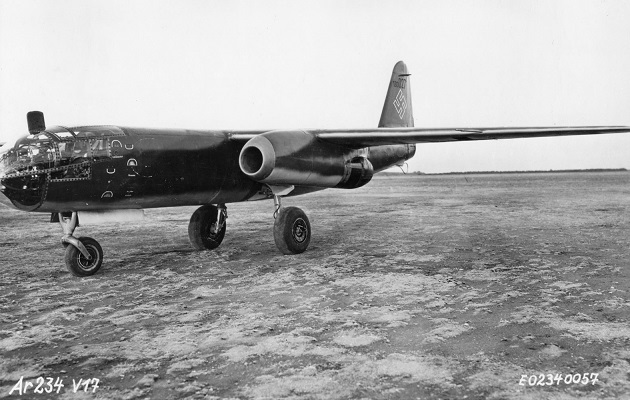
Film: Arado Ar 234 Blitz – The First Jet Bomber
Film: Arado Ar 234 & Variants
Film: WW2 ERICH SOMMER LUFTWAFFE ARADO 234 JET PILOT
He 162
The Heinkel He 162 Volksjäger (“People’s Fighter”) was a single-engine, jet-powered fighter developed under the Jägernotprogramm (Emergency Fighter Program). It was designed and built quickly and made primarily of wood as metals were in very short supply and prioritized for other combat aircraft currently in production. Other names given to the plane include the “Salamander”, which was the code name of its wing-construction program, and Spatz (“Sparrow”), which was the name given to the plane by the Heinkel aviation firm.
The He 162 was notable for its small size, almost the same length as the Me 109 and its wing was much shorter. Most distinctive was its top-mounted engine, combined with its ground-hugging landing gear allowed the engine to be easily accessed for maintenance. Its wooden construction did gave it a much smaller radar signature compared to other aircraft at the time. Its small size left little room for fuel, combined with the inefficient engine resulted in a very short combat time which was about 20 minutes, and it only had room to mount two cannons.
The He 162 was the first single engine aircraft to have an ejection seat. The seat had the parachute stored in the seat pan and the pilot buckled himself into the seat. The seat was launched by firing a cartridge hence the name “Schleudersitz Heinkel-Kartusche” (Ejection seat Heinkel cartridge). Other early German ejection seats were powered by compressed air. A He 162 ejection seat is on display in the Deutsches Museum in Munich, Germany.
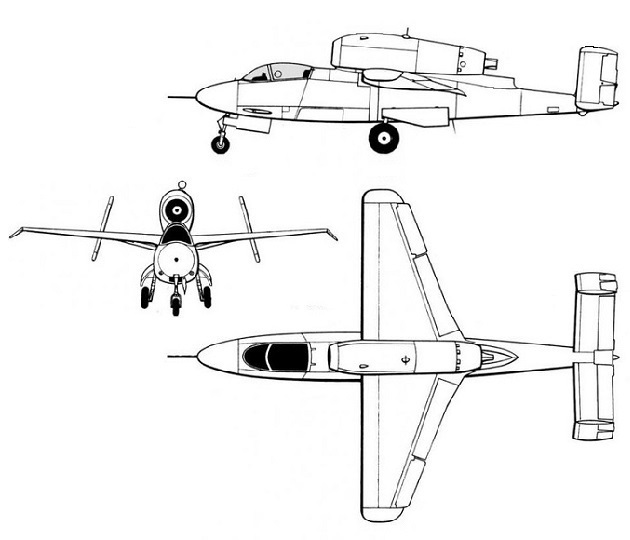
Variants
He 162A-0: first ten pre-production aircraft
He 162A-1: armed with two 30mm (1.18 in) MK 108 cannons with 50 rounds per gun
He 162A-2: armed with two 20mm (0.78 in) MG 151/20 cannons with 120 rounds per gun
A series of fatal accidents during testing requiring more modifications delayed the program and it eventually entered into service in January 1945 as an excellent light fighter. The delivery of the He 162 to Luftwaffe front units was limited due to many reasons, including slow production, lack of fuel and spare parts and the Allied advance, but eventually, a couple units equipped with this aircraft were formed.
Film: He 162 – Germany’s Emergency Wooden Fighter Jet Kept Falling Apart
A German He 162 jet factory in a salt mine near Schönebeck on the west bank of the Elbe, about 14 km (9 miles) southeast of Magdeburg in May 1945. The wooden fuselages of the He 162s are seen lined up in the assembly hall waiting for the engines and other components to be installed.
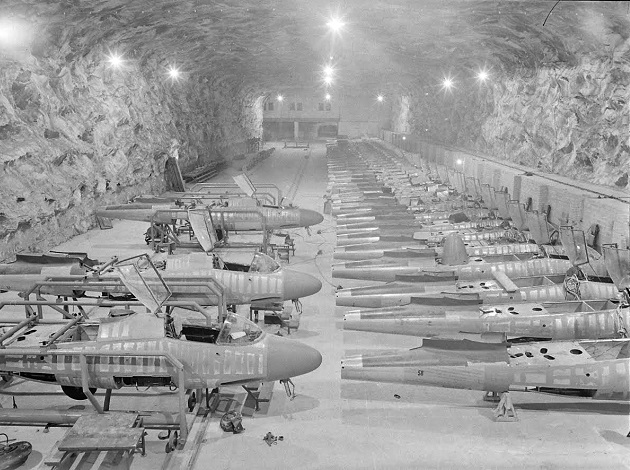
Captured He 162A-1, Werknummer 120067, White 4 at Kassel-Waldau Airfield (Advance Landing Ground Y-96) in Germany on 14 August 1945.
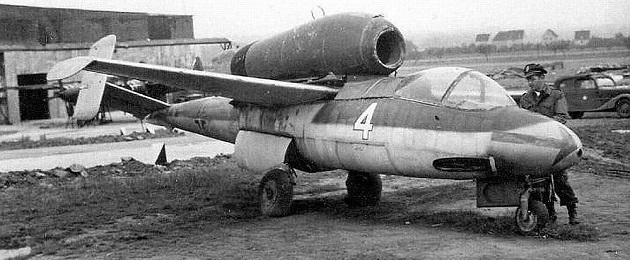
Video: Me 262 vs He 162 – Which one was better?
Allied pilots quickly found that the only reliable way to destroy the jets and rocket fighters was to attack them on the ground or during take off/landing. Luftwaffe airfields that were identified as jet bases were frequently bombed by medium bombers, and Allied fighters patrolled over the airfields to strafe and catch jets taking off or landing. The Luftwaffe countered by setting up extensive flak alleys of AA guns along the approach lines to protect the jets from the ground and by providing top cover while the jets were taking off or landing with the most advanced Luftwaffe single engine fighters, the Focke-Wulf Fw 190D nicknamed Dora; or Long-Nose Dora (“Langnasen-Dora”) and the Focke-Wulf Ta 152H Höhenjäger (“high-altitude fighter”) which was becoming available in 1945. In March–April 1945, Allied fighter patrols over the Luftwaffe airfields resulted in many jet losses.
Able to outrun the escorting Allied fighters, the Me 262s were almost impossible to catch in straight level flight. As a result, Me 262 pilots were relatively safe from the Allied fighters, as long as they did not allow themselves to get drawn into low-speed turning dogfights and save their maneuvering for higher speeds.
Boomerang
Pilot:
Captain Arthur. F. Jeffrey (17 November 1919 to 18 April 2015)
Unit:
434th Fighter Squadron, 479th Fighter Group, US 8th Air Force, based at Wattisham, England
Plane:
Lockheed P-38J-15-LO Lightning, s/n 42-104425, named “Boomerang”
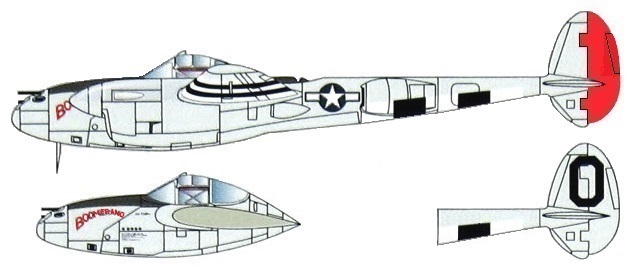
On 29 July 1944, the 100th Bomb Group target was the Leuna Oil Refinery at Merseburg, Germany (8 bombers were lost). One of the B-17s was hit over the target receiving damage to two engines and the vertical stabilizer/rudder causing the bomber to lag behind the formation as well as wounding a waist gunner in the abdomen and his upper left leg. The bomber was a Douglas-Long Beach B-17G-35-DL Flying Fortress, s/n 42-107007, (Square-D) Green nose band, coded EP ☆ B, named “She-Hasta” of the the 351st Bomb Squadron.
Captain Jeffrey and his wing man, First Lieutenant Richard G. Simpson, were providing withdrawal support for the group with Jeffrey leading “Newcross Yellow” Flight. Near Wesermünde, Germany, Jeffrey noticed B-17 “She-Hasta” steadily falling behind the formation and was heading northwest, a heading that would cause it to miss England completely. Jeffrey led his wing man down to gave “She-Hasta” some close support and navigational assistance. Although the P-38 had a very unique design, the gunners of the rookie crew manning the B-17 did briefly fired at the Lightnings as they approached. Once recognized as friends, the two P-38’s joined up with “She-Hasta”. The B-17 plodded along at 11000 feet (3352.8 meters) dodging holes in the overcast to avoid flak, and at 1145 hours Jeffrey spotted a Me 163 in an attack position behind “She-Hasta”.
The Me 163 made a slight low side 5 o’clock pass at the B-17, went into a slight dive and then leveled off. Probably became aware of the P-38s, the German made another slight dive and then started a very steep climb, weaving all the while. During this weaving, Jeffrey closed in on him and opened fire, observing hits on the Me 163. At 15000 feet (4572 meters), the Me 163 leveled off and started to circle to the left, as though positioning for an attack. The P-38 was able to turn tighter than the Me 163 allowing Jeffrey to get a good defection shot at a range about 200 to 300 yards (183 to 274 meters). The Me 163 took some hits and smoke started to pour out from the tail. The Me 163 then turned and made a head on attack towards Jeffrey. The two went into a tight circle and Jeffrey seen a few of his good defection shots hitting the Me 163. The Me 163 then rolled over and went into a near vertical dive at more then 500 mph (805 km/h). Jeffrey followed the Me 163 down into the steep dive firing at the Me 163. He seen his tracer path walking forward on the Me 163 fuselage. Jeffrey then got into an arc of an outside loop and pulled out a few hundred feet above the ground before blacking out. The damaged Me 163 which certainly had exhausted all its rocket propellant would not been able to pull out of the dive and at that speed the pilot probably would not been able to bale out.
Lightning Strikes a Komet by Roy Grinnell
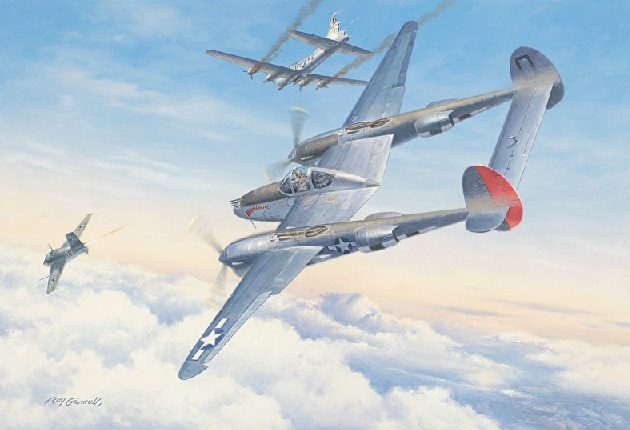
Jeffrey reported the claim as a probable but later it was upgraded to destroyed. This was the first victory over a Me 163 Komet and the only one scored in a P-38 Lightning. It was Jeffrey’s 2nd kill.
A ground crewman posing next to “Boomerang” displaying the victory markings.

The Me 163 was from Erprobungskommando 16 which took off from Fliegerhorst (Air Base) Bad Zwischenahn, 2 km (1.24 miles) north of Bad Zwischenahn (town hall). Information of who the pilot was or any record of any Me 163s lost that day has not been found.
B-17 “She Hasta” ran out of fuel near the western Frisian Islands off the north coast of the Netherlands and the pilot was able to ditch successfully but the crew was unable to rescue the badly wounded waist gunner. The crew drifted ashore at Ameland Island (occupied by the Germans) at 1745 hours on August 1st and the survivors became POWs for the rest of the war.
Between 13 – 27 September 1944, the 479th Fighter Group transitioned to the P-51D Mustang. Jeffrey’s Mustang was a P-51D-10-NA, s/n 44-14423 coded L2 ☆ O, named “Boomerang Jr.” At the end of his combat tour, Lieutenant Colonel Arthur Jeffrey, age 26, was in command of the 434th Fighter Squadron and he became the 479th Group’s top scoring ace with 14 confirmed aerial victories.
About 60 years later, Jeffrey was credited by navigator Bob Fulkerson for saving the lives of the B-17 “She Hasta” crew.
Model Kits and Decals
1/48:
Minicraft Model Kits 11649 P-38J LIghtning – 2012
PRINT SCALE Decals 48-157 P-38J Lighting Aces over Europe (1944-45) Part-1
1/72:
Hasegawa 02820 U.S. Lockheed P-38 J/L Lightning – 1995
AGA 113 P-38 J Lightning – 2019
PRINT SCALE Decals 72-353 P-38J Lighting Aces over Europe 1944-1945
DETROIT Miss
Pilot:
First Lieutenant Urban Leonard Drew (24 March 1924 to 3 April 2013), known as Ben Drew
Unit:
75th Fighter Squadron, 361st Fighter Group “Yellowjackets”, US 8th Air Force based at RAF Little Walden located north of Saffron Walden, Essex, England.
Plane:
North American P-51D-10-NA Mustang, s/n 44-14164, coded E2 ☆ D , named “DETROIT Miss”

On Saturday, 7 October 1944, Urban Drew was leading “Decoy Squadron” on a mission escorting 3rd Air Division B-17s attacking oil industry targets in the Böhlen (south of Leipzig) – Lutzkendorf (east of Bamberg) area. Drew led his flight beneath the bombers to engage enemy fighters which had intercepted other escorts but by the time they reached the area all the fighters were nowhere in sight. Not able to relocate his assigned B-17s, Drew joined a box of homeward bound red tailed B-17s who needed some escorts.
As Drew’s flight neared Achmer Aerodrome located 4 km (2.48 miles) southwest of Bramsche, Germany, two Me 262s were beginning to take off. While watching the two jets taking off from 15000 ft (4572 m), Drew rolled in with 2nd Lieutenants Robert McCandliss (his wing man) and Bill McCoppin on his wing. When Drew leveled off at tree top level, his speed was so fast that he was concerned about overshooting. Also flak from the airfield had become heavy and accurate.
Drew caught up with the second Me 262 when he was at an altitude of 1000 ft (304.8 m) flying at 450 mph (724.2 km/h) and the jet was flying around 200 mph (321.87 km/h). Drew started firing at about 400 yards (365.76 m) with a 30° deflection shot. As he closed in on the jet, he observed hits all over the fuselage and wings. Suddenly, the jet exploded and Drew flew right through the fireball and the debris. Once clear of the explosion, Drew briefly looked back and observed the jet wreckage falling and then he switched his attention to the other Me 262. The pilot of the destroyed jet was reported to been Leutnant Gerhard Kobert of Kommando Nowotny flying Me 262A-1a, Werknummer 110405.
The pilot of the leading Me 262 had made a fatal mistake. Instead of continuing to accelerate and try to outrun Drew’s P-51, the German pilot turned into his attacker (Drew). The Me 262 was 60° angle off and Drew was going more than 400 mph (643.7 km/h) when he rolled into a 90° left bank and pulled 6Gs. While fighting the painful Gs, Drew kept trying to get his gun sight on the German jet. While getting close to blacking out, Drew finally managed to get his sight locked on the tail of the jet. He immediately opened fire, walking his tracer rounds along the fuselage and shattered the canopy. The jet then went into an invert spin and crashed to the ground at a 60° angle. Astonishingly, the German pilot either baled out or was thrown out of the stricken jet.
The identity of the Kommando Nowotny pilot who flew the leading Me 262 is not certain. Several sources stated a number of possible pilots and aircraft. These two are the most probable Kommando Nowotny pilots:
| Pilot | Me 262A-1a Werknummer | Combat Record | Notes |
|---|---|---|---|
| Oberleutnant Paul Bley | 170307 | At least 9 kills, one with Me 262 | Killed on take-off in Me 262A-1a, Werknummer 110388, on 28 October 1944 |
| Oberfeldwebel Heinz Arnold | 110405 | 49 kills, last 7 with Me 262 in March 1945 | KIA on 17 April 1945 |
Luftwaffe fighter Gruppe “Kommando Nowotny”, commanded by Major Walter Nowotny, was formed for testing and establishing tactics for the Messerschmitt Me 262 jet fighter. As a unit, Kommando Nowotny flew only three combat missions, between 3 to 24 October 1944 and claimed 22 victories.
The gruppe consisted of three Staffeln based at Achmer and Hesepe Airfields:
I. Staffel commander: Oberleutnant Paul Bley (see above table)
II. Staffel commander: Oberleutnant Alfred Teumer
(October 4, killed due to engine failure on landing Me 262A-1a, Werknummer 170044, at Hesepe)
III. Staffel commander: Hauptmann Georg-Peter Eder
(Transferred in from JG 26 and on October 8 took command)
Within one minute, Ben Drew had shot down TWO German jet fighters. However his glory was short-lived, his claim for the two kills were denied due to the lack of evidence. First, the gun camera in his Mustang had malfunctioned. His wing man, Robert McCandliss was hit by flak forcing him to bale out of his Mustang before it crashed and became a POW. Bill McCoppin had been too busy strafing flak batteries to see either jet go down.
Video: The 1st WW2 Jet Kill
Video: Urban Drew
More than 35 years later, a US Air Force clerk noticed Drew’s claim for two Me 262 victories on the same mission. She contacted a custodian of German war records who knew former Luftwaffe pilots whom might be able to provide some information on the claim. Georg-Peter Eder (8 March 1921 to 11 March 1986) was then a businessman in Wiesbaden, stated that he saw a yellow-nosed P-51 dive on the Me 262s as they were taking off and it shot them down. Eder was not able to read “Detroit Miss” on the nose of the Mustang, but his corroboration was sufficient enough to confirm Drew’s two Me 262 victories.
On 12 May 1983, the 14th US Secretary of the Air Force, George Vernon Orr, Jr., presented the Air Force Cross to Urban Drew. He is one of the only three airmen to receive the Air Force Cross for his actions in WWII.
| Date | # | German Type | Location | Aircraft Flown |
|---|---|---|---|---|
| 25 June 1944 | 1 | Messerschmitt Me 109 | Lisieux, France | P-51B |
| 25 August 1944 | 1 | Me 109 | Rostock, Germany | P-51B |
| 11 September 1944 | 1 | Me 109 | Göttingen, Germany | P-51D |
| 18 September 1944 | 1 | Heinkel He 111 | Fehmarn Belt | P-51D |
| 7 October 1944 | 2 | Me 262 | Achmer, Germany | P-51D |
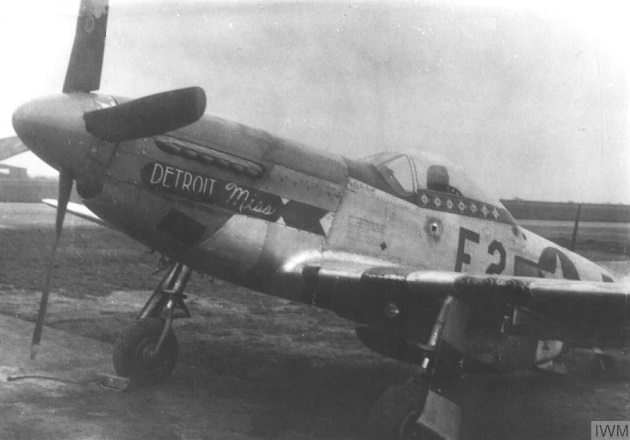
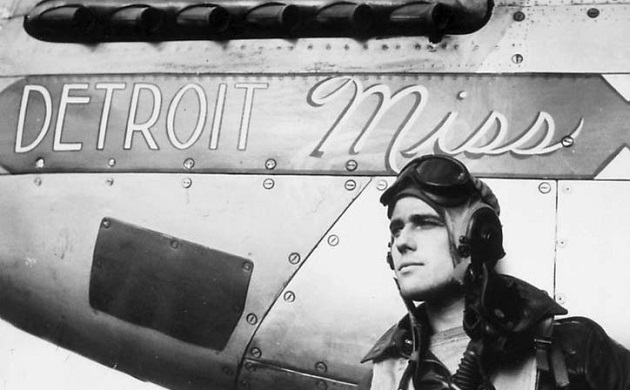
Model kit and Decals
1/32:
AeroMaster Decalset 32-015 Yellow Nose Mustangs of the 361st F.G Part I – 2004
1/48:
AeroMaster Decalset 48-657 Yellow Nose Mustangs of the 361st F.G Part III – 2004
CAM Decalset 48-115 Thoroughbred Mustangs
1/72:
Airfix A50183 Messerschmitt Me262A-1A & P-51D Mustang Dogfight Doubles – 2021
Draw Decal 72-P51-93 “Detroit Miss” P-51D – 2018
Lifelike Decals 72-038 North American P-51 Mustang Pt.4 (English) – 2018
Glamorous Glen III
Pilot:
Captain Charles “Chuck” Elwood Yeager (13 February 1923 to 7 December 2020)
Unit:
363rd Fighter Squadron, 357th Fighter Group based at Theberton/Saxmundham, England
Plane:
North American P-51D-15-NA Mustang, s/n 44-14888, coded B6 ☆ Y , named “Glamorous Glen III” after Yeager’s fiancé, Glennis Fay Dickhouse
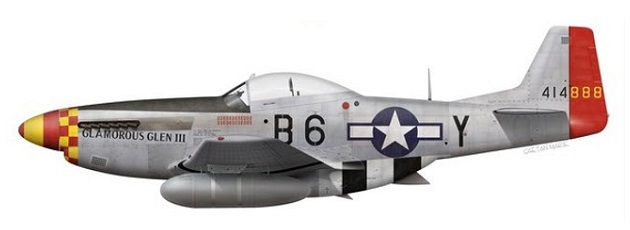
On 6 November 1944 while leading “White” Flight at 8000 feet (2438.4 meters) just north of Osnabrück, Germany, Captain Yeager spotted three Me 262s flying in a “V” formation on a reciprocal course to his flight just above a broken layer of clouds at 5000 feet (1524 meters). As Yeager led his flight down, the enemy jets took no evasive action, even after he made one or two hits with a 90° deflection shot from 400 yards (365.76 meters). The German pilots relied on their superior speed and outran the P-51s, disappearing in a haze layer. Undeterred, Yeager dropped down through the haze layer, and after about a minute he made contact with the jets again head-on, with the jets slightly below him at 2000 feet (609.6 meters). He split-essed down and got the enemy flight leader in his gun sight, scoring several hits on the wings and fuselage, but the jet still managed to pull away and disappear into the haze again.
At this point, Yeager had become separated from his flight, and as he climbed back up to 8000 feet, he spotted a large airfield which he began to circle. Yeager then spotted a lone Me 262 approaching the runway from the south at 500 feet (152.4 meters) at low speed around 200 mph (321.87 km/h). Yeager split-essed on it and was going about 500 mph (804.67 km/h) at 500 feet. Enemy flak began coming up and was accurate. Yeager fired a short burst from about 400 yards and had to break off at about 300 yards (274.32 meters) because the flak was getting to too thick. Glancing back, he seen the enemy jet crash landed about 400 yards short of the airfield in a wooded field.
Yeager’s First Jet by Roy Grinnell
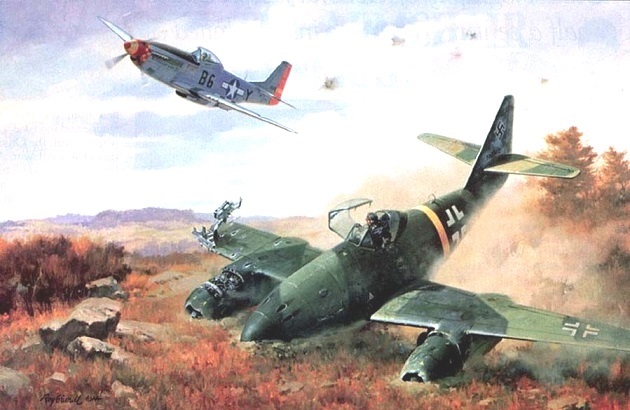
Video: Chuck Yeager vs Me 262 (1944)
Yeager finished the war with 12.5 aerial victories which included five Me 109s on October 12 (‘ace-in-a-day’) and four FW 190s on November 27. He completed his final flight on 15 January 1945 where he completed a total of 64 combat missions accumulating 270 combat flying hours.

P-51D-15-NA, s/n 44-14888, was later renamed “Melody’s Answer” and was lost when it crashed due to an unknown cause at Haseloff, west of Treuenbrietzen, Germany on 2 March 1945 and the pilot was killed.
Model kits and Decals
1/32:
Hasegawa 08115 P-51D Mustang ‘Glamorous Glennis’ – 2000
Peddinghaus Decals EP2655 P-51D-15-NA Captain “Chuck” Yeager, 357th FG – 2012
1/48:
Tamiya 61089 North American P-51D Mustang 8th A.F. Aces – 2003
AeroMaster Decalset 48-478 Mustangs Forever Part 3 – 1999
1/72:
Tamiya 60773 North American P-51D Mustang 8th A.F. Aces – 2005
Peddinghaus Decals EP2571 P-51D-15-NA Mustang “Glamorous Glen III” Chuck Yeager WWII
Lady Nelda / June Nite
Pilot:
First Lieutenant Edward Ross “Buddy” Haydon (24 April 1920 to 20 November 2012)
Unit:
364th Fighter Squadron, 357th Fighter Group based at Theberton/Saxmundham, England
Plane:
North American P-51D-5-NT Mustang (built in Dallas, Texas), s/n 44-11165, coded C5 ☆ J , named “Lady Nelda” after Haydon’s fiancé, Nelda Augusta Parish

Pilot:
Captain Ernest Charles Fiebelkorn (12 December 1922 to 6 July 1950)
Unit:
77th Fighter Squadron, 20th Fighter Group based at Kings Cliffe, England.
Plane:
P-51D-5-NT Mustang, s/n 44-11161, coded LC ☆ N , named “June Nite” after his wife June.
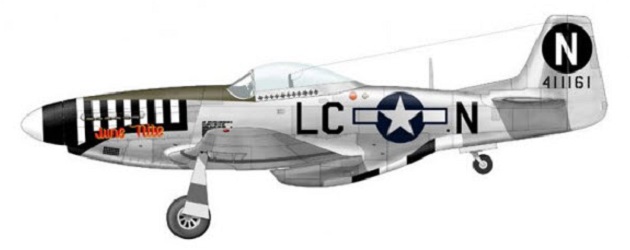
On 8 November 1944, while disobeying orders not to fly, Major Nowotny of Kommando Nowotny flying Me 262A-1a, Werknummer 110400 attacked an enemy bomber formation flying at 30000 feet (2787.1 meters). In the engagement, he had just scored his 257th (a B-17) and 258th (a P-51) aerial victories (the 258th was his 3rd kill in the Me 262) before suffering an engine failure at high altitude. While in a gradual dive flying on one engine, he tried desperately to restart his other engine.

Meanwhile, the 364th FS, 357th FG had been strafing ground targets west of Hanover, and during these attacks Captain Merle Allen and his wing man, First Lieutenant Haydon, were separated from the rest of their squadron. The lone pair were heading west back towards England when they spotted a single Me 262 and they began to chase it. Unknown to them at the time, the jet was Nowotny’s. There were several other Mustangs also chasing Nowotny’s Me 262 at the time including Captain Fiebelkorn of the 77th FS, 20th FG.
Captain Fiebelkorn was leading “Yellow” Flight in the area of Dümmer Lake, Germany (southwest of Bremen and west of Hanover) when Nowotny’s Me 262 flew by his flight. Fiebelkorn immediately started after Nowotny’s jet and followed him in a dive down near the deck, where the Nowotny leveled out. Nowotny led the P-51s over an airdrome in a gradual turn and Fiebelkorn was cutting inside just within range when two P-51s (Allen and Haydon) cut in front of him before he could fire. Nowotny then pulled up into the overcast and immediately arched over onto his back and went into a steep dive crashing into the ground about 4-5 miles (6.44-8.05 km) from the airdrome.
Nowotny’s Final Encounter by Keith Ferris

In the engagement, only First Lieutenant Haydon actually fired at Nowotny’s Me 262. Captain Allen did not submit a claim because he did not fired at the jet and from Fiebelkorn’s Encounter Report, it appeared that he did not fired either. Based on Haydon’s claim and Fiebelkorn’s Encounter Report (and their gun camera footage), the USAAF credited a half victory to both Hayden and Fiebelkorn. This was Haydon’s only victory of the war.
It was Fiebelkorn’s 9th and his last aerial victory of the war including two strafing kills. Fiebelkorn became the highest scoring ace of the 20th FG.
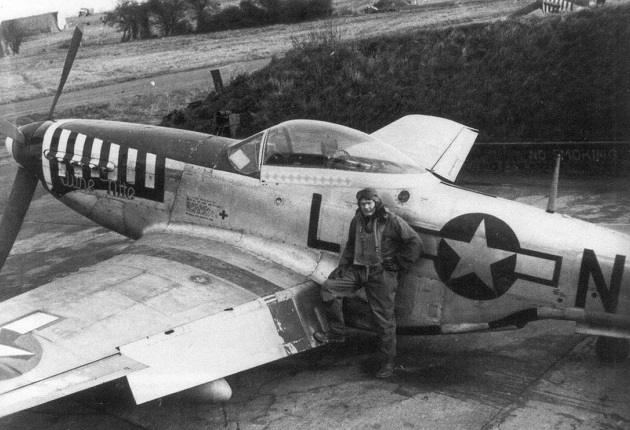
After Nowotny’s death, Hauptmann Georg-Peter Eder briefly commanded Kommando Nowotny until it was withdrawn from combat. The first operational jet fighter wing, Jagdgeschwader 7 “Nowotny” (JG 7), was formed and named in his honor. On November 19, Kommando Nowotny was re-designated as III. Gruppe of JG 7, no longer an independent unit.
On 20 January 1945, Haydon flying P-51D-5-NT “Lady Nelda”, s/n 44-11165, crash near Kaufbeuren, Bavaria and became a POW for about three and a half months.
After assigned to the 55th FS, 20th FG, P-51D-5-NT, s/n 44-11161, was destroyed when it crashed on take off at Kings Cliffe on 13 June 1945.
Model kits and Decals
1/32:
Trumpeter 02235 Messerschmitt Me 262 A-1a – 2005
Kits-World Decalset KW132026 War Birds P-51D Mustangs ‘Happy Jacks Go Buggy’ & ‘June Nite’ – 2011
1/48:
Revell 85-5322 Messerschmitt Me 262 A-1A – 2012
Kits-World Decalset KW148060 War Birds P-51 Mustangs ‘June Nite’ & ‘Happy Jacks Go Buggy’ – 2011
Bulleye Model Aviation Decals 48-012 P-51D – Yoxford Boys #4 (357th FG)
1/72:
Academy 12410 Messerschmitt Me262A-1a – 2007
Kits-World Decalset KW172046 War Birds P-51D Mustang ‘Happy Jacks Go Buggy’ & ‘June Nite’ – 2011
Tempest JBW
Pilot:
Wing Commander John Basil Wray
Unit:
No. 122 Wing, 2nd Tactical Air Force, RAF in North West Europe
Plane:
Hawker Tempest V, s/n EJ750, coded JBW (As his rank allowed him, his aircraft’s code was composed of his initials)
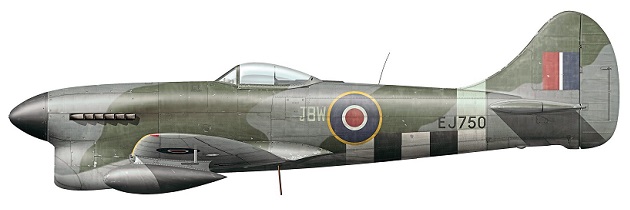
On 1 October 1944, Tempest Vs of No. 122 Wing commanded by Wing Commander Wray, arrived at B80 Volkel, the most forward Allied airfield in newly liberated Holland.
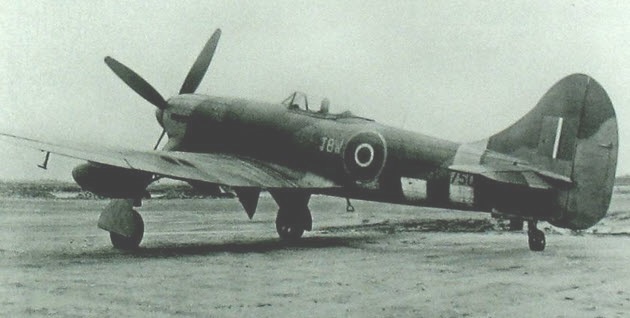
While flying an airfield patrol on November 3, Wing Commander Wray flying his personal Tempest, spotted two Me 262s flying southwest while he was at 18000 feet (5486.4 meters). On sighting him, the two enemy jets turned back. Using his altitude advantage, Wray dived after the right hand jet, and closing at high speed, opened fire before the jet got out of range. Suddenly a large chunk flew off the jet and it flipped over onto its back and went into an inverted dive through the cloud cover. Wray followed the jet down, but the thick cloud cover made it impossible for him to maintain contact. Although Wray claimed the Me 262 as damaged, German records states that Oberfähnrich Willi Banzhaff of Kommando Nowotny, flying Me 262A-1a, Werknummer 110483, crashed near Hittfeld-Lüneburg (south of Hamburg) and was killed around that time.
While on patrol on the morning of December 17, Wray was warned of jets in the area and spotted two aircraft fron II./KG(J) 51 close to the Rhine River. After ordering his wing man to go after the No. 2 jet, Wray pursued Me 262A-2a, Werknummer 110501, coded 9K+BP, flown by Leutnant Wolfgang Lübking, who was at low altitude. Wray was going flat out at about 450 mph (724.2 km/h) but was not closing the range. The Me 262 was about 200 yards (182.88 meters) ahead of him and pulling away. Visibility was poor and Wray realized that he might lose him. Wray then opened fire, firing a four second burst but with no visible hits. Then the jet started to turn slowly, so Wray pressed on again. Now the jet was right on the deck with Wray slightly above and behind him. Wray was able to catch up with the jet and opened fire again with strikes hitting the jet’s wings. The jet started to weave violently which allowed Wray to close in to about 300 yards (274.32 meters). Wray was about to fire again when the jet’s port (left) wingtip struck a building on the bank of the Rhine and the jet plunged straight into the river.
In early 1945, Tempest V EJ750 was transferred to No. 486 Squadron RNZAF (Code SA) and was written off in February 1945 when its pilot was forced to crash land after being hit by flak.
IWM 12371 Wing Commander Wray’s Oral history
Model Kits
1/32:
Special Hobby SH32070 Tempest Mk.V “Hi-Tech” – 2017
1/48:
Eduard R0018 Tempest Mk.V Royal Class – 2019
1/72:
Kovozávody Prostějov (KP) KPM0219 Hawker Tempest Mk.V “Wing Commanders” – 2021
PETIE 3rd
Pilot:
Lieutenant Colonel John Charles Meyer (3 April 3 1919 to 2 December 1975)
Unit:
487th Fighter Squadron, 352nd Fighter Group, US 8th Air Force based at Bodney, UK
Plane:
North American P-51D-15-NA Mustang, s/n 44-15041, coded HO ☆ M , named “PETIE 3rd”

In November 1944, Meyer became deputy commander (second-in-command) of the 352nd Fighter Group. On December 23, the 352nd Fighter Group relocated to Advanced Landing Ground Y-29 Asch in Belgium, located 4 miles (6.4 km) east-southeast of Genk (Limburg), approximately 50 miles (80 km) east-northeast of Brussels (Today: Zutendaal Air Base). While there, the group operated under the command of the US 9th Air Force.
On December 31, Meyer was leading the 328th Fighter Squadron (code PE) on a patrol when fighter controllers vectored them towards a group of bogies near Viviers, France. When the P-51 pilots dropped below the cloud cover, they spotted an Ar 234 bomber, which was immediately attacked by Captain Donald S. Bryan flying P-51K-5-NT Mustang, s/n 44-11628, coded PE ☆ J, named “Worra Bird 3/Bashful Betsy”. Bryan managed to hit the starboard engine of the Ar 234 prior to breaking off his pursuit when Meyer called out a second Ar 234 that was closing in on Bryan’s tail.
Meyer chased the second Ar 234 in and out of the clouds until he lost sight of it near Bonn, Germany. Just when he spotted it again, he noticed another Ar 234 heading towards Cologne and decided to chase it instead. Meyer could not get into range but fired several bursts from long range. Although he did not observed any hits on the Ar 234, he still submitted a claim for the Ar 234 as a probable kill. Later, Meyer was awarded credit for the USAAF’s first Ar 234 victory. It was Meyer’s 22nd kill.
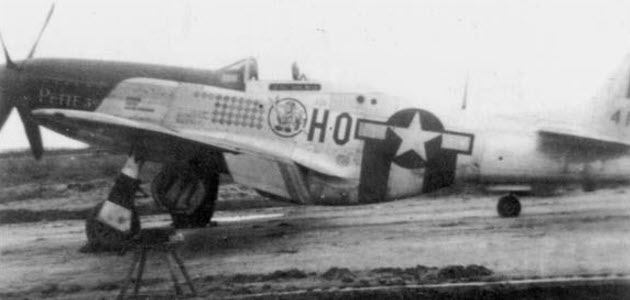
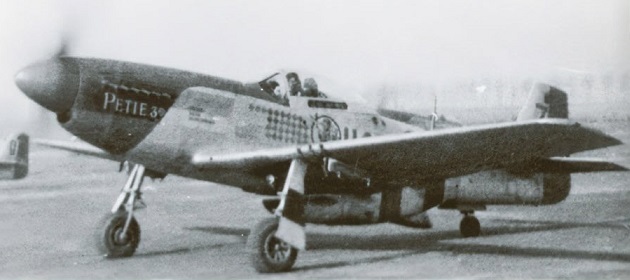
The next day, 1 January 1945, Meyer scored his 23rd and 24th victories. In early 1945, an automobile accident left Meyer with a severe leg injury which ended his combat flying with the 352nd group after flying 200 combat missions accumulating 462 combat flying hours and scoring 24 aerial victories with another 13 credited to ground strafing.
After the war, Meyer remained in the US Air Force. In the autumn of 1950, Meyer deployed to Korea as the CO of the 4th FIW flying F-86 Sabre jets. He shot down two MiG-15s and damaged a third bringing his total of enemy aircraft destroyed (air and ground) in both WWII and Korea to 39½.
Model kits and Decals
1/24:
Eagle Strike Productions Decals 24003 Blue Nose Birds of Bodney – 2002
1/32:
Eagle Strike Productions Decals 32045 P-51D Mustang Blue Nose Bodney – 2002
1/48:
Eduard 82102 P-51D Mustang ProfiPack Edition – 2022
Hasegawa 09707 P-51D Mustang ‘Petie’ – 2006
1/72:
Draw Decal 72-P51-58 P-51D “Petie 3rd” – 2017
Operation Bodenplatte
On 1 January 1945, the Germans launched Operation Bodenplatte (“Baseplate”) which was the Luftwaffe’s attempt to crush the Allied air forces in the Low Countries. The objective of Bodenplatte was to gain air superiority during the stagnant stage of the Battle of the Bulge so that the German Army and Waffen-SS forces could resume their offensive. The operation was planned to begin on 16 December 1944, but was delayed repeatedly due to bad weather until New Year’s Day, the first day that the weather was suitable for flying. The operation did achieved some surprise and tactical success, but in the end was a failure. Many Allied aircraft were destroyed on the ground but they were replaced within a week. The Germans lost many planes and pilots which could not be readily replaced.
The only German jets that participated in the operation were 21 Me 262A-1s of KG 51 “Edelweiss” supporting the attack on RAF Gilze-Rijen Airfield (codename B.77) located between the cities of Breda and Tilburg. A number of different RAF day and night fighter squadrons used Gilze-Rijen flying Supermarine Spitfire Mk.Vs and Mk.IV/P-51D Mustangs.
Operation Bodenplatte was the Luftwaffe’s last large scale strategic offensive operation of the war.
La-7 Kozhedub
Pilot:
Major Ivan Nikitovich Kozhedub (8 June 1920 to 8 August 1991)
Unit:
The first La-7 fighters re-equipped the 19th Fighter Aviation Regiment in June 1944 and in August 1944 the regiment was renamed the 176th Guards IAP (Guards Fighter Aviation Regiment). This regiment was also known as the “Marshal”.
Plane:
Lavochkin La-7 White 27, armed with two 20mm ShVAK cannons and a top speed of 661 km/h (411 mph)

Kozhedub was an ace universally credited with 64 solo victories. He was considered to be the highest scoring Soviet and Allied fighter pilot of WWII. He was one of the few pilots to have shot down a Me 262 jet, and the first Soviet pilot to have done so. He was made a Hero of the Soviet Union (Gold Star Medal) on three occasions (4 February 1944, 19 August 1944, and 18 August 1945).
On 17 February 1945, Kozhedub flew out on a free hunt paired with Dmitry Titarenko. On the traverse of the Oder River, the pilots spotted an aircraft rapidly approaching from the direction of Frankfurt an der Oder. The enemy plane was flying along the riverbed at an altitude of 3500 meters (11483 feet) at a speed much greater than the La-7 could attain. It was a Me 262 and Kozhedub instantly made a decision. The Me-262 pilot relied on the superior speed of his aircraft and did not control the airspace behind or below him. Kozhedub attacked from below on a head-on course, hoping to hit the jet in the belly. However, Titarenko opened fire before Kozhedub. To the considerable surprised Kozhedub, the premature firing of his wingman was beneficial. The German banked to the left, towards Kozhedub, allowing Kozhedub only to line up the Me 262 in his gunsight and press the trigger. The Me 262, Werknummer 900284, flown by Unteroffizier Kurt Lange of 1./KG(J) 54 turned into a fireball, east of Altfriedland. The Me 262 was Kozhedub’s 55th victory so his plane would only had 54 kill markings and two Hero of the Soviet Union metals on that day.
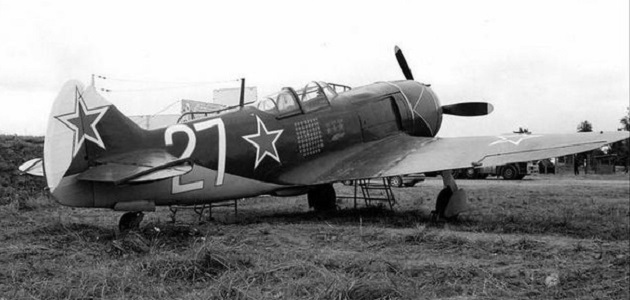
Video: Іван Кожедуб | Пишемо історію
La-7 numbered 27 is now preserved in the Central Air Force Museum at Monino located 40 km (25 miles) east of Moscow.
The serial number of the plane at the museum is 45210127, where:
45 is for La-7
21 is for Zavod 21 at Gorky (now Nizhny Novgorod)
01 is the series (very early)
27 is the unit within the series, the same as the bort number on the fuselage.
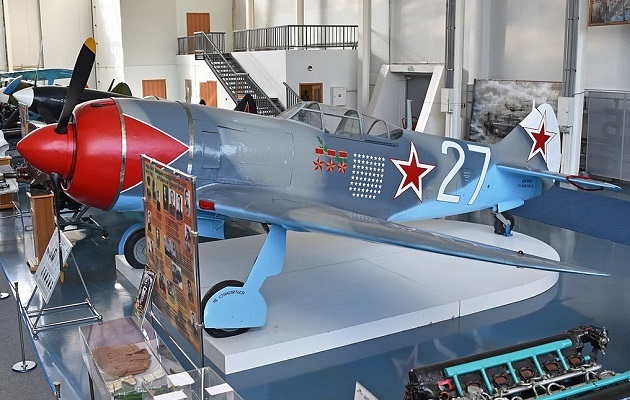
Video: Lavochkin La-7 “white 27” I.N. Kozhedub… in detail
Model Kits
1/32:
HpH models 32032R Lavochkin La-7 – 2014
1/48:
Hasegawa 07995 Lavochkin La-7 Ivan Kozhedub – 2014
1/72:
Eduard 7066 La-7 ProfiPack – 2016
Ludendorff Bridge
Allied pilots were not the only ones to shoot down German jets in WWII. On 7 March 1945, elements of the US 9th Armored Division, US 1st Army reached the Rhine River at Remagen and discovered the Ludendorff Railway Bridge intact. After heavy fighting and a failed German attempt to blow up the bridge, the US infantry captured the bridge by the evening. US engineers made repairs to the bridge and had laid down steel tread way sections on the bridge. The bridge repairs were completed by midnight and only one way vehicular traffic was permitted to cross the bridge. The night was rainy and very dark, which necessitated great efforts from all concerned to keep traffic moving at all times. A tank platoon of Company A, 14th Tank Battalion crossed successfully and then a Tank Destroyer (TD) platoon of Company C, 656th Tank Destroyer Battalion began to cross. However, around midnight, the leading M18 TD had slipped off a steel tread way on the bridge in the darkness and became wedged between two cross members of the bridge structure, thereby blocking all vehicular traffic. By 0300 hours, the stuck M18 TD was finally towed or pushed off the bridge allowing vehicles to resume crossing again.
On March 8, the Germans counter attacked with two under strength panzer divisions. The 9th and 11th Panzer-Divisions were hurried to counter the buildup of the US 1st Army bridgehead at Remagen. Because of poor weather conditions, the day was cold with rain and low overcast caused US aircraft to be grounded and were unable to provide air cover over the bridge. However, the Germans attempted air raids over the bridge with ten aircraft, eight of which were Junkers Ju 88 Stuka dive bombers. By afternoon, the US 482nd Anti-aircraft Artillery (AAA) Battalion had three batteries at the bridge site with three platoons on the east and three platoons on the west bank of the river, while the 413th AAA Battalion (90mm) setup positions on the west bank. Of the ten attacking enemy aircraft, eight were shot down. Nearly 1000 US troops, along with tanks and artillery, had crossed the bridge by nightfall.
M16 MGMC half-tracks mounting quad .50 Cal MGs of the US 482nd AAA Battalion protecting the Ludendorff bridge.
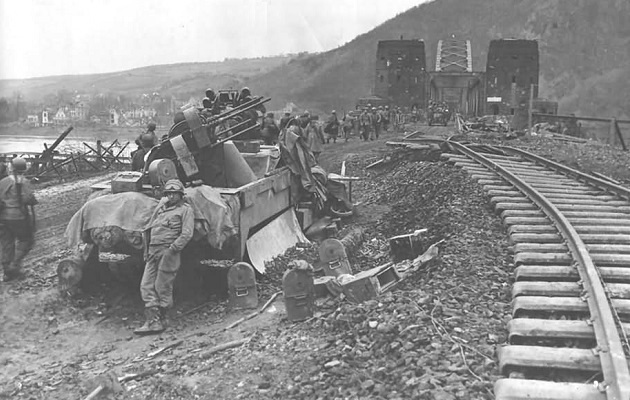
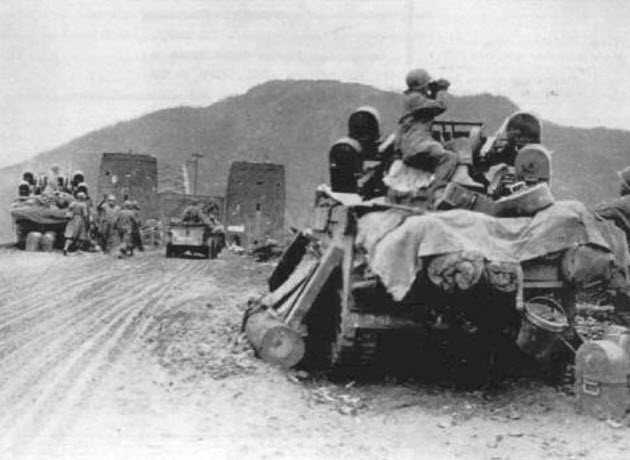
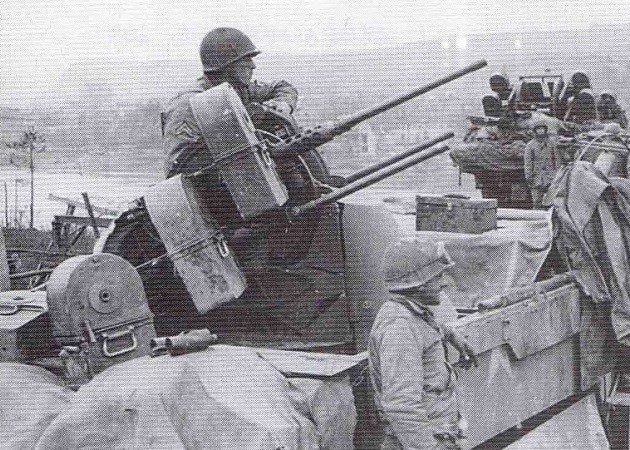
Film: US troops capture and defend the Ludendorff Bridge over the Rhine River at Remagen
Film: REMAGEN NEWS
Film: REMAGEN BRIDGEHEAD COLOR 1945
Because of German air attacks and the artillery fire, the engineers at the bridge site requested that smoke be employed, and requests were made to the US 1st Army for a smoke generator unit. Because none was available at that time, smoke pots were gathered from all available sources. Thirteen M3 Lee CDL Gizmo tanks (search lights mounted on tanks) from the US 736th Tank Battalion (spec) were used to assist in protecting the bridge at night against floating mines, riverboats, etc., and explosive charges were dropped into the river at five-minute intervals throughout the night to discourage enemy frogmen from demolishing the bridge.
On March 9, an assortment of German aircraft attacked the bridge including Fw 190s, Me 109s, and Me 410s. Later in the day, III./KG 76 (Ar 234s) commanded by Oberstleutnant Robert Kowalewski began flying sorties against the bridge carrying 1000 kg (2200 lb) bombs with Me 262 fighter-bombers of I./KG 51 providing cover. Three Ar 234s were sent in. The US AA fire was very heavy and one Ar 234 was shot down while one was reported missing. By this time, five US AAA battalions were positioned around the bridge.
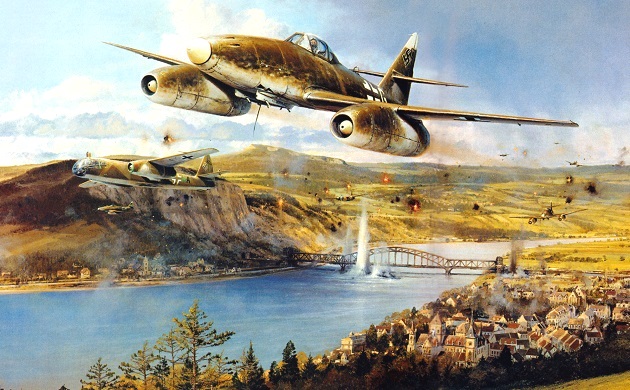
On March 10, it was decided to build two temporary pontoon bridges spanning the river. The Ludendorff Bridge needed repairs, but the Allies did not want to slow down the movement of troops and supplies over the Rhine into Germany. The US 51st and 291st Combat Engineer Battalions began constructing a pontoon and tread-way bridge, as well as a ferry system with pontoons and landing craft to put even more Allied troops, tanks, and weaponry across the Rhine. While the 90mm M26 (T26E3) Pershing tanks were too heavy to cross the bridges, they were soon across using the new ferry system. The area of the bridgehead was expanded with the 99th Infantry Division, the 9th Armored Division, and 78th Infantry Division all crossing to the east bank of the Rhine River.
On March 11, two more Ar 234s from III./KG 76 attacked the bridge. On March 12, four Ar 234s flew over the bridge at noon, followed by 12 more escorted by Me 262s later in the day. The next day, nineteen Ar 234s attack the bridge again without success.
On March 14, eleven Ar 234s turned their attention to the newly constructed pontoon bridge south of the Ludendorff Bridge. The Luftwaffe jets encountered withering flak, and they were pounced by RAF Tempests and Spitfires, along with US P-51s. At least 5 German aircraft were shot down.
Video: The Luftwaffe’s desperate jet attack to destroy the bridges at Remagan
On March 15, 21 German jet aircraft attacked the bridges with poor results. US AA batteries shot down more than half of these fast moving aircraft. On March 17, the Ludendorff Bridge finally collapsed on its own from all the punishment it had taken.
Film: Damaged and twisted Ludendorff Bridge at Remagen
The pontoon bridges and ferry system remained in operation transporting troops and materials over the Rhine River. This was the first jet bomber assault and the defense of the Remagen Bridges ranks as one of the greatest AAA battles in US history.
Devastatin’ Deb
Pilots:
Major George Eugene Bostwick (19 October 1919 to 6 February 1990)
Captain John Conrad Fahringer (18 September 1918 to 20 September 1999)
Unit:
63rd Fighter Squadron, 56th Fighter Group, US 8th Air Force based at Boxted, Colchester, UK
Plane:
Republic P-47M-1-RE Thunderbolt, s/n 44-21160, coded UN ☆ F, named “Devastatin’ Deb”
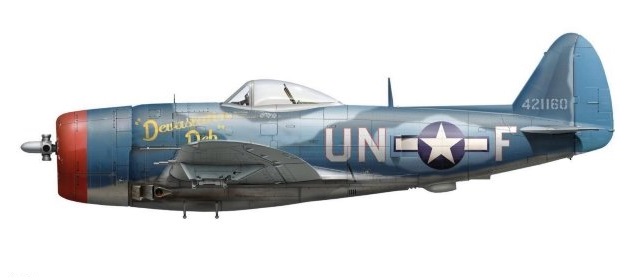
P-47M
The Thunderbolt manufacturer Republic set aside four bubble-canopy P-47Ds from its production line in Farmingdale, New York and fitted them with souped-up Pratt & Whitney R-2800-57 Double Wasp engines with the CH-5 turbo-supercharger. Together, these generated 2800 horsepower. The YP-47M prototypes attained a climb rate of 3500 f/s (1066.8 m/s) and a maximum speed of 473 mph (761.2 km/h) in level flight although some pilots reported achieving 490 to 500 mph (643.7 to 804.6 km/h) when using Wartime Emergency Power. This made the P-47M arguably the fastest piston-engine fighter to see combat in the war but it was still slower than the Me 262’s 540 mph (869.0 km/h) maximum speed. The P-47M still required to carry drop tanks for the long escort missions over Germany. The first P-47Ms, delivered in December 1944, were rushed to the 56th Fighter Group, the last 8th Air Force fighter unit equipped with the P-47. The P-47Ms began arriving on 3 January 1945. The new “hot rod” P-47Ms experienced a number of engine failures which caused several crashes. By March 24, all the engine problems were resolved and the group commenced combat operations with the P-47M.
On 25 March 1945, 63rd FS CO Major Bostwick was leading his flight flying P-47M-1-RE, 44-21160, “Devastatin’ Deb” (Captain Fahringer’s assigned plane) on a Ramrod mission over Hitzacker, Germany. The P-47M pilots pursued a number of enemy jets as they fled eastward towards their base at Parchim (near Rostock). Bostwick lined up on a Me 262 that was on its final approach for landing. However, instead of landing, the jet continued flying down the runway and flew directly over another Me 262 that was taking off. Bostwick shifted his gunsight to the Me 262 which was taking off and fired a burst just as the German pilot broke left. Instead of turning out of Bostwick’s line of fire, the pilot dug his jet’s port (left) wingtip into the ground, causing the fuel-laden Me 262 to cartwheel and then exploded. Bostwick then turned his attention back to his original target, firing an ineffective burst from more than 800 yards (731.5 meters) as the jet flew out of range. The Me 262 was Bostwick’s 6th victory and he would claim two more kills on April 7 (as well as damaging another Me 262) to finish the war with 8 victories, plus 7 strafing victories. Bostwick’s assigned plane was P-47M-1-RE, s/n 44-21112, coded UN ☆ Z, named the “Ugly Duckling”.
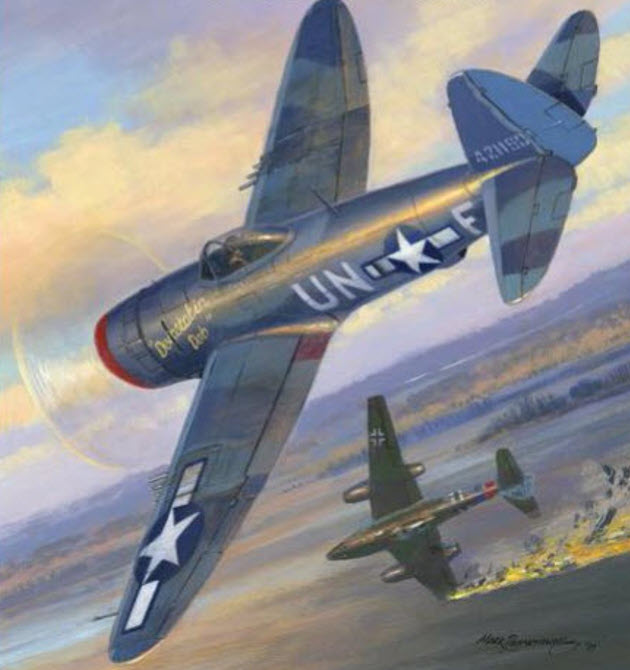
Artist: Mark Postlethwaite
On the morning of April 5, 53 P-47Ms of the 56th Fighter Group were escorting formations of B-17s to Regensburg, Germany, when a lone Me 262 made a pass from 3 o’clock to 9 o’clock and shot down a B-17 from the 401st Bomb Group. The jet pilot then started a right turn almost immediately in front of “Blue” flight of the 63rd FS, led by the squadron’s Operation Officer, Captain Fahringer, flying P-47M-1-RE, 44-21160, “Devastatin’ Deb”. The P-47M pilots jettisoned their drop tanks and headed down in pursuit. First Lieutenant Phillip Kuhn fired first and overshot the jet. Then Fahringer got on the Me 262’s tail and fired several bursts with no hits. The German pilot then made the fatal mistake of tightening this turn, which allowed Fahringer to close into lethal range. At 500 yards (457.2 meters), Fahringer opened up again with his eight .50 Cal machine guns. As smoke began streaming from the stricken jet, Fahringer seen something flash pass the right side of his plane. It was the German pilot of the Me 262 who baled out. The Me 262 was Fahringer’s 4th victory. Unfortunately, the war in Europe ended and Fahringer did not became an ace.
Model Kit
1/72:
Revell 03984 P-47M Thunderbolt – 2013
Volksjäger
Jagdgeschwader 1 “Oseau” (JG 1) commanded by Oberst (Colonel) Herbert Ihlefeld (1 June 1914 to 8 August 1995) was the first and only operational unit to fly the He 162 in combat. By the end of March 1945, JG 1 was supplied with around 58 operational He 162A-2 aircraft with about 25 more on the way. At the same time, I./JG 1 was moved to Ludwigslust, where it was supposed to be supplied with new He 162 aircraft. Due to the Allied rapid advance, the unit was moved in April to Leck airfield (Today Leck Air Base) located near Leck, Germany approximately 30 km (18.6 miles) north of Husum, and 30 km west of Flensburg near the Danish border. The unit had orders to defend Berlin from Allied bombers flying over the North Sea. I./JG 1 became ready for operational service on 20 April 1945.
The first operational combat mission of I./JG 1 was an attack on a RAF forward airfield on April 20. While en-route, the He 162’s were intercepted by a group of RAF 3. Squadron (Code JF) Hawker Tempests. In this engagement, only one He 162 was shot down and the German pilot managed to survive without any injuries. At the same time, a P-51 Mustang pilot of the US 12th Tactical Reconnaissance Squadron reported to have shot down one He 162, but it was never officially confirmed.
On 5 May 1945, a RAF unit occupied Leck Airfield and they found 45 He 162s of which 15 were combat ready, and 30 in final assembly. A curious British soldier sat himself in the seat of one and activated the ejection seat. He was ejected from the aircraft and thrown about 30 meters (100 feet) into the air, before falling to the ground without a parachute.
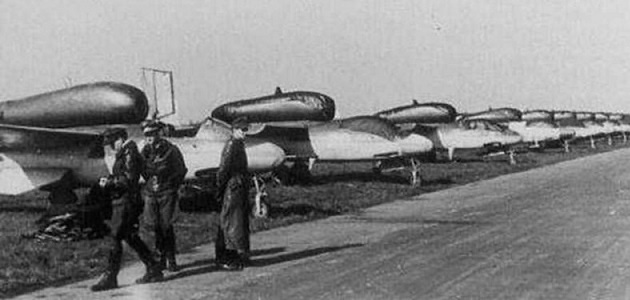
This is He 162A-2, Werknummer 120230, which was flown by Oberst Herbert Ihlefeld of I./JG 1 at Leck airfield. It was shipped back to the USA during Operation LUSTY (LUftwaffe Secret TechnologY) and is currently in possession of the National Air and Space Museum collection. Unfortunately, it is not available for public viewing.
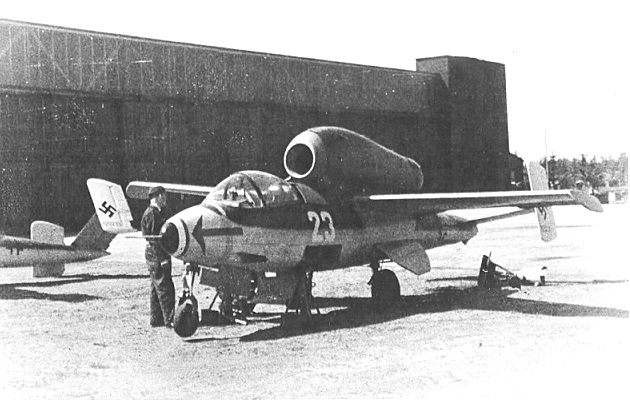
After the Allies started bombing and strafing the Luftwaffe airfields, the Germans relocated their squadrons to remote areas along German highways. Long straight lengths of highway were used as the runway and along side the highways concealed in forests were the hangers, workshops and other buildings.
Two well camouflaged Me 262s in a forest near Burgau. This photo shows very well how cleverly the secret base in the woods was concealed. The barracks and production halls were located between narrow tree trunks and were also covered with camouflage nets. The Me 262 in the foreground is a Sturmvogel fighter-bomber version with bomb mounts underneath the forward fuselage. Note the rear of a US M2 half-track in the foreground.
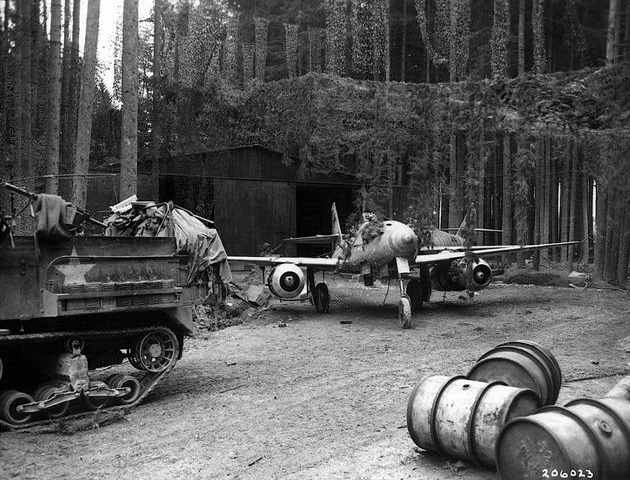
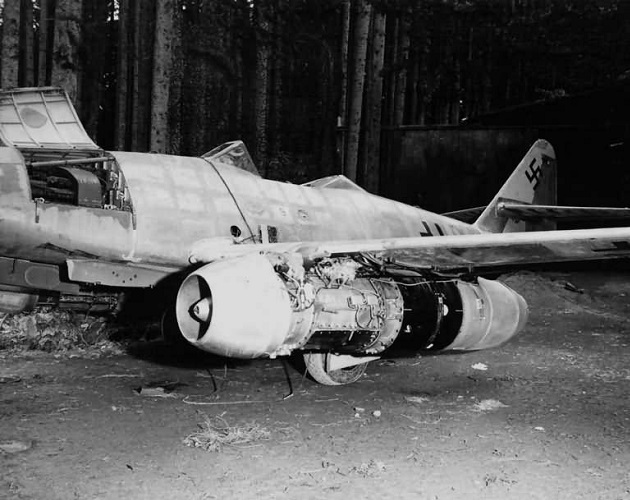
Film: 1945 Me-262 Jet Fighters on the German Highway
US Army officers inspect an abandoned Me 262 near Frankfurt airfield, photographed by Margaret Bourke-White for LIFE Magazine, May 1945. Bourke-White was the first American female war photojournalist.
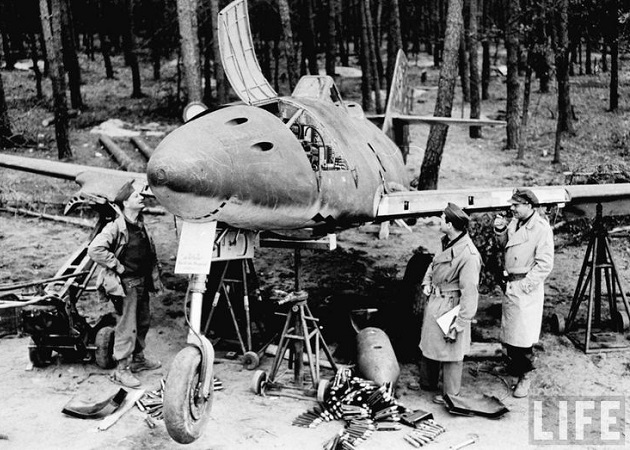
This photo shows six Komets, most likely captured in the Leipzig area, waiting to be trucked to a central collection point, for possible evaluation. The location has been confirmed to be Merseburg (west of Leipzig and north of Leuna), Germany, April-May 1945. The closest Komet is Me 162B-0 “White 42”, and it belonged to III./JG 400. The badge is either of the 13th or 14th Staffel. Unfortunately, it is not clear in this photo.
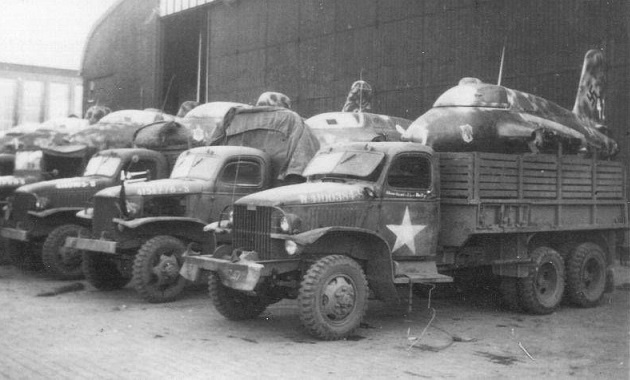
This is a photo of the starboard (right) side of White 42. The wing appears to been cut off with a welding torch. The location of this photo is unknown.
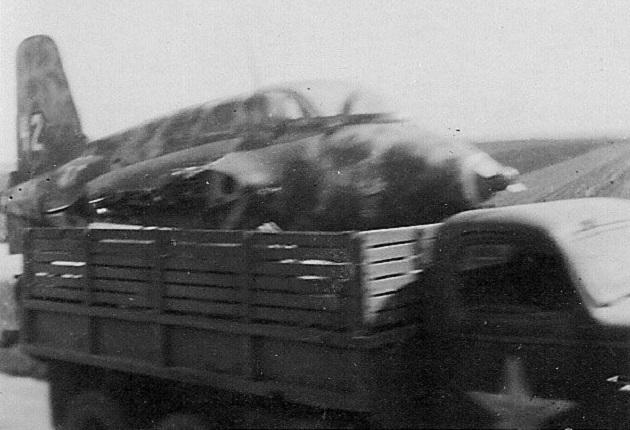
Ba 349
The Bachem Ba 349 Natter (Colubrid, grass-snake) was a German point-defence rocket-powered interceptor, which was to be used in a very similar way to a manned surface-to-air missile. After a vertical take-off from a launch tower, which eliminated the need for airfields, most of the flight up to the enemy bombers altitude was controlled by an autopilot. The primary role of the untrained pilot was to aim the aircraft at its target enemy bomber and fire its armament of rockets. The pilot and the fuselage containing the rocket motor would then land using separate parachutes, while the nose section was disposable. The first and only manned vertical take-off flight was on 1 March 1945, at the Truppenübungsplatz Heuberg, which ended in the death of the test pilot, Lothar Sieber, who was an experienced Ar 232 pilot. The Ba 349 Natter never went into production.
Four jettisonable Schmidding boosters were used for the launch. These units were used for jet-assisted take-off (RATO) on large or heavy Luftwaffe aircraft. Armament was either 24 × 73mm (2.874 in) Henschel Hs 297 Föhn spin-stabilized rockets or 33 × 55mm (2.165 in) R4M rockets.
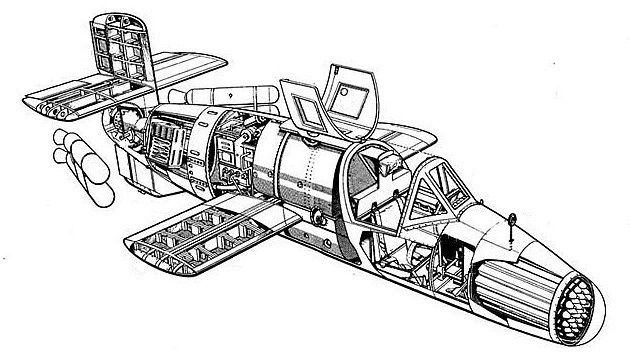
Bachem Ba 349A-1 Natters recovered by US troops at St. Leonhard im Pitztal, Tyrol, Austria in May 1945. On the rear of the fuselage is one of the Schmidding boosters.
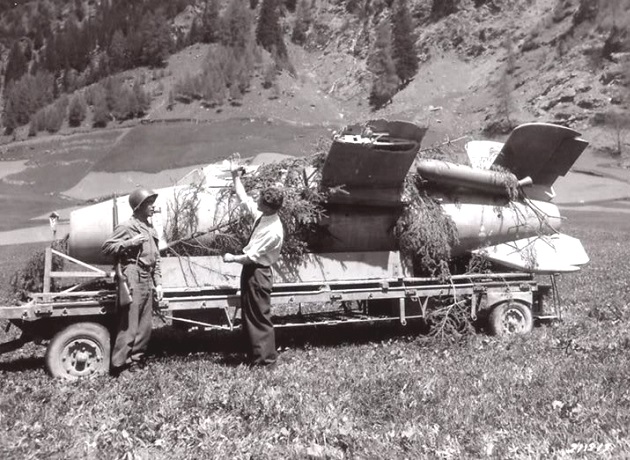
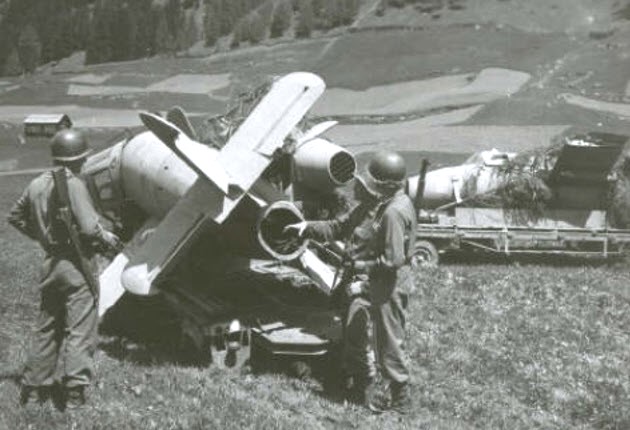
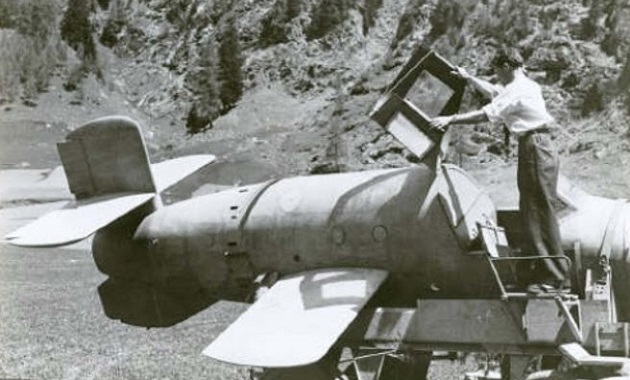
This front view shows the nose with 24 tubes for the 73mm Hs 297 Föhn rockets.
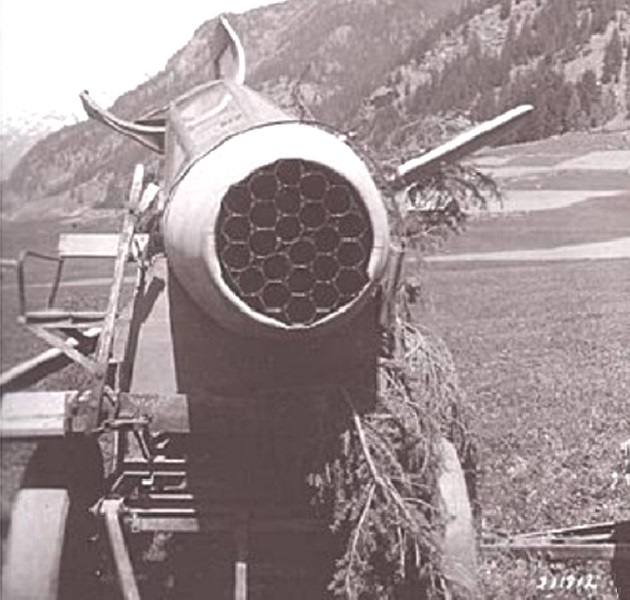
Film: Captured German Secret Weapons: Bachem Ba 349 Natter and Ruhrstahl X-4 (May 1945)
Post War
Film: Captured Messerschmitt 262 (Me 262) demonstrated in 1947.
Video: Messerschmitt Me 262 “Schwalbe” – First Flight Over Berlin after 61 Years, Historical Footage!
Video: AIRPOWER 2016 – Full Messerschmitt Me 262 Flying Display.

Reblogged this on My Forgotten Hobby V.
LikeLike